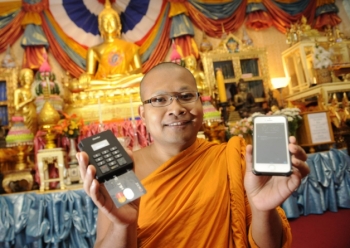When I was a teenager, the familiar tune of a dial-up connection echoing through my house was a sure sign that the mighty internet was about to come alive. Today, in 2014, internet is a household staple, and as readily available as the numerous 7-Elevens on Hong Kong’s streets. The buzzing of phones, the beeping of new messages, the familiar blue-tinged light emanating from a foot away . . . are signs of a new age where the internet travels snugly in our back pockets and smart phones are better friends than high school BFFs. And now, to think, the internet is only one component of the ever-growing phenomenon of unstoppable technological revolutions. Mankind can now peek into valleys on Mars, 3D-print the next meal, and explore a plethora of possibilities that were unthinkable just a few decades ago.
When technology becomes such an integral part of our lives, and a low battery means a near-death experience, how do those of us who thrive on simplicity survive? How do we keep our spiritual goal glowing green? Buddhism is sometimes called an “akalika,” or “timeless,” religion. For 2,500 years, Buddhists all over the world have adapted to changing times, cultures, and traditions. Yet, Buddhism does remain inherently the same, and in fact this surge in technological progress has benefited the peaceful religion.
A recent example is that of the monks at the Dhammapadipa temple in Edinburgh, who may have just revolutionized the way monastics handle money. Monks are forbidden to handle cash, so those in charge of receiving sangha donations are positively delighted by the news. Buddhadharma reports that the Edinburgh monks have created an iZettle—a mini credit-card reader that attaches to smartphones or tabs and can then be used to receive donations from all over the world. No cash is handled, and it is super fast! As Nina Fernstrom, strategic partnership developer at iZettle, told the Edinburgh Evening News: “We’re delighted to be helping with the monks’ efforts to raise money for a new building in Edinburgh.” A modern, safe, and fast way to handle money, and a collective “phew” from Buddhists worldwide!
Sakyong Mipham Rinpoche, head of the Shambhala Buddhist lineage and author of The Shambhala Principle and Running with the Mind of Meditation, believes that technology has left a positive impact on us if we feel “uplifted, informed or delighted by it.” He says in his Huffington Post blog that these are signs of a virtuous encounter. “However, if we feel dull or disconnected, then clearly that technology has numbed our senses . . . . Technology can be a great expeditor of virtue, or it can create negativity,” he goes on to warn. Many may think an excess of anything can’t be good, and with the fast pace of modern living, Buddhism too has evolved to embrace it all.
Another addition to the list of technological innovations catering to Buddhists is the mobile phone app “Love.” Before you raise your eyebrows, let me assure you of the wonderful purpose behind the app. “Love: A Tiny Buddha app” allows a user to receive motivational and spiritual quotes, improve their ability to express their feelings, and build healthier relationships by developing a positive outlook. How? The app can be timed to send you questions, challenges, affirmations, and quotes throughout the day. The app is the brainchild of Lori Deschene, who runs the website Tiny Buddha, a portal that aims to help people “reflect on simple wisdom and learn new ways to apply it to our complex lives.” We all could use a dose of inspiration.
As we dream about the technological wonders the next two decades may hold, perhaps somewhere in the world they are already rough sketches or even 3D models on a supercomputer. Buddhism has coped exceptionally well so far. “It’s fantastic that this community, with its ancient roots, is embracing new technology,” encourages Nina Fernstrom. Hopefully it will continue to acclimate to such developments, and we urge Buddhists around the world to embrace change for a positive fut . . .
















